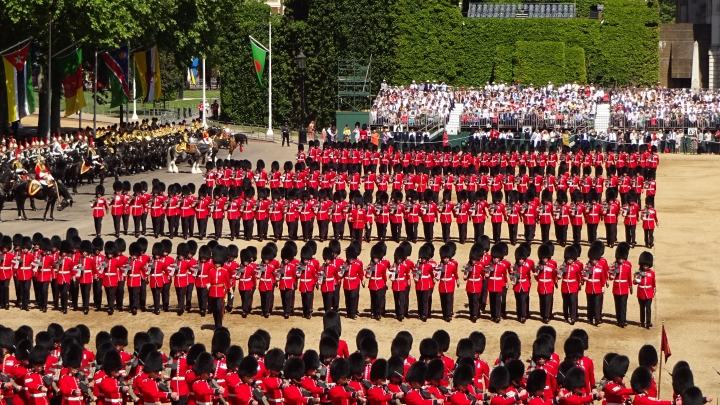Trooping the Colour - Colonel's Review
1st June 2019By the kind invitation of Alan Beggs, our Company's Clerk's Assistant and Honorary Secretary of the Irish Guards Association, the Mistress and I were invited to the Trooping of the Colour - Colonel's Review along with Master-Elect Andrew Golding and his wife Kate. The Learnéd Clerk, Sandra Stocker, was also in attendance to keep a close eye on us all, just three days before the Installation Court.
The weather was not simply fine but positively Mediterranean that day and, as we took our seats, we were all very appreciative of the shade that our row of seats enjoyed. This was intentional on Alan's part. In his former life as a Musician in the Irish Guards that included 66 outings for The Trooping of the Colour, he knows only too well the discomfort that can be caused by hot, sunny days even for those merely seated at Horse Guards Parade.
In the Middle Ages, lords and barons flew their own banners by which their private armies could distinguish them in battle. These banners came to be called Colours and were used by individual Companies within Batallions, their role was to provide a rallying point on the battlefield. To allow troops to find their Colours in the chaos of battle, they needed to recognise them and so it became the practice in the army to display them regularly. This was achieved by parading the troops and having an officer march along the ranks with Colours held high. Whilst Colours have not been carried into battle since 1881, trooping ceremonies continue to this day and, on this occasion, the Colours being trooped were those of 1st Battalion Grenadier Guards.
The Foot Guards present were the Grenadier Guards, the Coldstream Guards, the Scots Guards, the Irish Guards and the Welsh Guards. The Household Cavalry present were the Life Guards, the Blues & Royals and the Household Cavalry Regiment. Last but not least was the King's Troop Royal Horse Artillery. Accompanying all of these was the Band of the Household Cavalry and the Bands of the Foot Guards.
The Companies marched on to the parade ground in sequence preceded by their respective Bands. They organised themselves to receive the Royal Procession that proceeded to inspect the line of Foot Guards. The Massed Bands and Drums then march across the Guards Parade in slow and quick time in preparation for the collection of the Colour to be trooped by the Escort. Once collected, the Escort to the Colour presents arms and the Massed Bands play the National Anthem. After further manoeuvres, the Colour is then trooped along the ranks of the Guards until complete. Finally, there is the March Past by the Foot Guards, the Walk and Rank Past by the Royal Artillery and mounted Companies before the march off. In all, this complex and vivid spectacle takes two hours to perform. A truly wondrous and magnificent miltary display with Horse Guards Parade ringing to the sound of the most sublime miltary music. It was an assault on the senses and an occasion that made you proud to be British.
With all ceremony over, Alan invited our small party to join him at Wellington Barracks nearby to take in the scenes of the returned Companies, soldiers and horses. The place was buzzing, all were elated at the job well done and eager to shed their uniforms for civvies after the baking conditions of the morning. Our visit to the Barracks was capped by refreshments and lunch in the Sargeants Mess; a perfect finish to a very special day.




